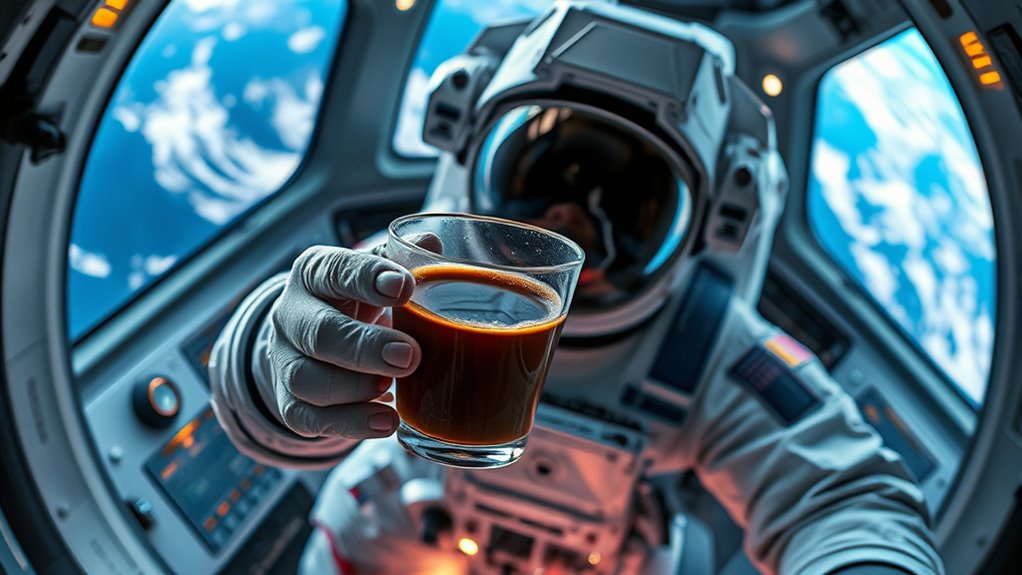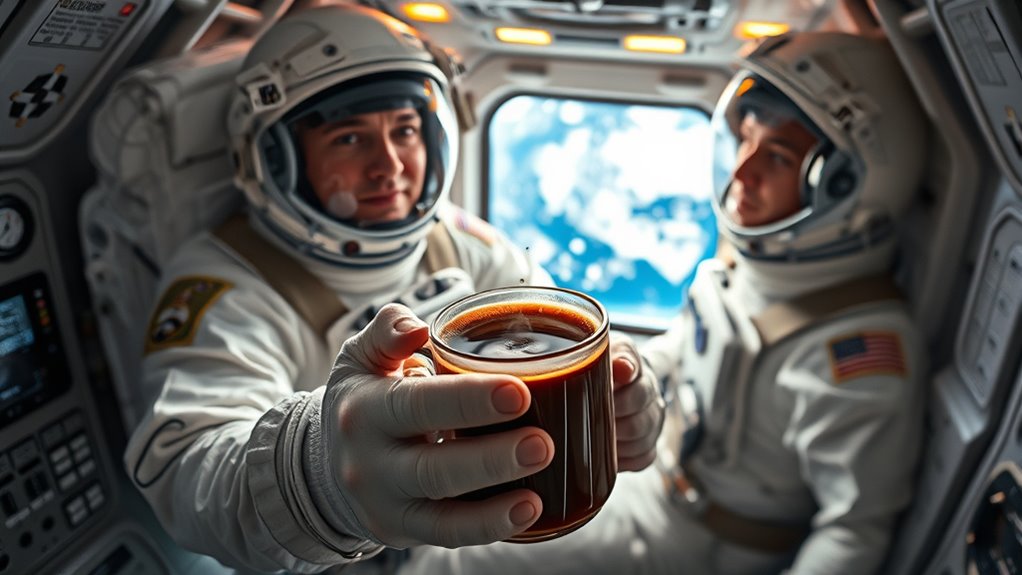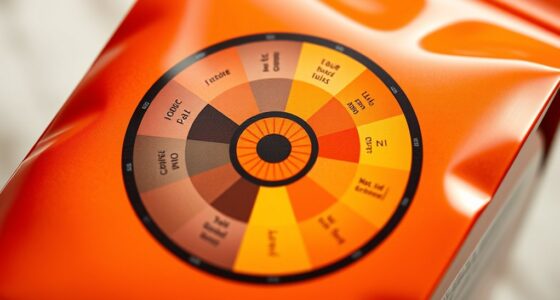In space, astronauts enjoy coffee using specially designed cups that prevent spills in microgravity, often sipping through straws or rehydrating freeze-dried coffee. Their brewing involves recycling water from waste, with tools like 3D-printed brewers or espresso machines making the process easier. These innovations offer comfort and routine, helping astronauts feel closer to home. Curious about the unique techniques and equipment they use? Keep exploring to learn more about how coffee transforms space routines.
Key Takeaways
- Astronauts enjoy coffee in space using specially designed cups and straws to prevent spills in microgravity.
- Coffee is often freeze-dried and rehydrated with recycled water for easy storage and preparation.
- Advanced brewing devices like 3D-printed cups and compact espresso machines enable authentic coffee experiences.
- Coffee provides astronauts comfort and routine, often served during special occasions or celebrations.
- Water recycling systems are essential for brewing, ensuring sustainable and safe coffee preparation in space environments.

Coffee in space has become more than a novelty; it’s an essential part of astronaut life. From the historic Apollo 11 mission to today’s advanced space stations, astronauts have found ways to enjoy their favorite brew despite the challenges of microgravity. The first hot coffee in space was available during Apollo 11, marking a milestone that showed even in the vacuum of space, comfort and routine matter.
Coffee in space transforms routine into comfort, proving even in microgravity, astronauts enjoy a familiar touch of home.
Since then, methods of consumption have evolved, with astronauts drinking coffee through straws or specially designed space cups that prevent spills while floating in microgravity. These innovations make it possible to enjoy coffee without creating chaos or wasting precious resources.
Most space coffee today is freeze-dried, a practical choice because it’s lightweight and has a long shelf life. When preparing it, astronauts rehydrate the powder with hot water, drawn from the station’s recycling system, which conserves water by recycling wastewater. The reconstituted coffee is then sipped from sealed bags using straws, ensuring minimal spillage.
For a more traditional experience, Kjell Lindgren used a 3D-printed Space Cup Brewer during Expedition 44/45 to make pour-over coffee, showcasing how technology continues to enhance space brewing. This innovative device allowed for a more authentic coffee experience, akin to what you’d find on Earth, despite the microgravity environment.
In 2015, Samantha Cristoforetti brought a small Italian espresso machine to the International Space Station, a significant leap forward. This compact espresso maker, along with a Lavazza machine used by William Shepherd, demonstrates how space agencies are investing in specialized equipment to bring espresso to astronauts.
Water for brewing is carefully managed; it’s recycled from wastewater, reducing waste and conserving resources. Brewing coffee in space isn’t simple—low gravity makes pouring and drinking more complex, requiring specially designed cups and techniques to prevent liquids from floating away.
Over time, the ways astronauts enjoy coffee have become more sophisticated. The use of 3D-printed equipment, compact espresso machines, and sealed drink bags has transformed the space coffee experience. Drinking coffee in space isn’t just about caffeine; it provides astronauts with a sense of routine, comfort, and a touch of home amid the vastness of space.
Special occasions often call for espresso, adding a sense of celebration or normalcy. As technology advances, the dream of savoring a fresh cup of coffee in orbit becomes more achievable, blending innovation with comfort and keeping astronauts energized on their journeys beyond Earth. Additionally, color accuracy plays a role in how astronauts perceive the visual quality of their coffee images on screens, enhancing the overall experience.
Frequently Asked Questions
How Do Astronauts Prevent Spills When Drinking Coffee in Zero Gravity?
You might wonder how astronauts prevent spills when drinking coffee in zero gravity. They use specially designed tools like the Capillary Cup, which relies on capillary action and surface tension to maintain the liquid inside.
The cup’s angled channel directs the coffee toward their mouth, eliminating the need for traditional tilting. This innovative design ensures a spill-free, comfortable drinking experience no matter how they hold the cup in microgravity.
What Types of Coffee Are Used Aboard Space Missions?
You might wonder what types of coffee astronauts use onboard. They primarily rely on freeze-dried coffee for its lightweight, long shelf life, and instant coffee for quick, easy preparation.
For a richer experience, they use specialized espresso machines like ISSpresso. Sometimes, they get specialty brews or explore space-roasted beans.
These options help meet their needs for convenience, variety, and comfort during long missions.
How Is Coffee Brewed in Microgravity Environments?
You learn that brewing coffee in microgravity involves specialized techniques and equipment. You use capsule-based espresso machines, force air drip systems, or unique containers that rely on surface tension to control liquids.
These methods prevent messes and account for fluid behavior changes. You also benefit from collaborations between NASA and companies like Lavazza, leading to innovations that deliver richer flavors and better aroma, even without gravity.
Do Astronauts Prefer Coffee Over Other Beverages in Space?
Think of space as a vast, quiet ocean where your favorite drink is a treasured island. You might find yourself reaching for coffee more often than other beverages because it’s like a familiar lighthouse guiding you through the darkness.
Many astronauts prefer coffee over tea or flavored drinks because caffeine helps them stay alert, and its strong taste offers comfort in the weightless environment, making it a space-faring favorite.
How Does Space Travel Affect the Taste of Coffee?
You notice that space travel changes how coffee tastes because microgravity reduces your ability to smell, which is essential for flavor perception.
Fluid shifts and congestion-like symptoms further dull your taste buds. Without Earth’s convection currents, the aroma and flavor don’t diffuse normally.
As a result, you might find coffee less rich or less satisfying, but new brewing methods and specialized cups help improve the experience, bringing some familiar taste back in space.
Conclusion
As you imagine sipping coffee among the stars, remember that even in the vast emptiness of space, your favorite brew becomes a bridge between worlds. Astronauts turn gravity’s challenge into a dance, transforming their cups into rockets of flavor. Just like a warm hug in the cold cosmos, coffee in space reminds us that no matter where we are, a simple cup can bring comfort, connection, and a taste of home among the infinite black velvet sky.









